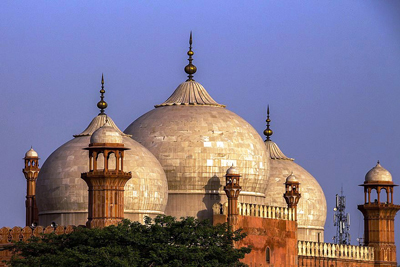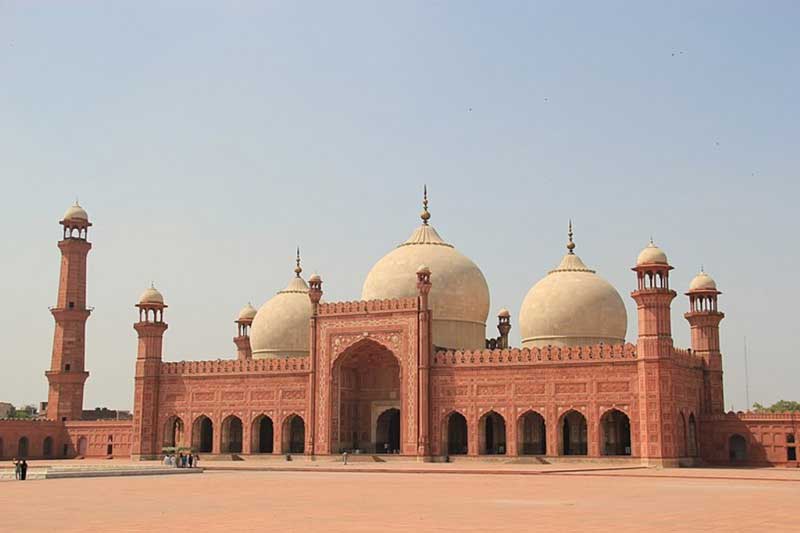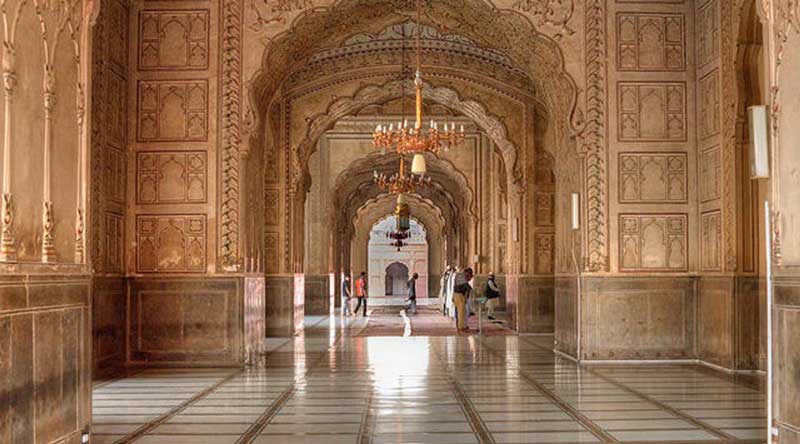
Located adjacent to the Walled City of Lahore, in Pakistan, and constructed by the Mughal emperor Aurangzeb between 1671 and 1673, the Badshahi Mosque closely resembles the architecture and design of the Jama Masjid in Delhi, India. With an exterior decorated with carved red sandstone with marble inlay, it is an important example of Mughal architecture and is widely considered to be one of the most iconic landmarks of Lahore.
Its massive courtyard, paved with sandstone and spreading over an area of 276,000 square feet (25, 641 sq m), has the capacity to accommodate 100,000 worshippers at a time and can even contain the Taj Mahal in it. Ridiculously, although the huge mosque was constructed during the reign of Aurangzeb, unlike the preceding emperors, he was not an ardent patron of art and architecture. He rather focused on various military activities during much of his reign, and the Badshahi Mosque, despite being considered a tremendous religious structure, its history has witnessed more use as a military base. Initially, the mosque was built to commemorate Aurangzeb's military campaigns in southern India, in particular against the Maratha, under the leadership of Chhatrapati Shivaji, and as a symbol of its importance, it was built directly across and just a few hundred feet to the west of the massive Lahore Fort.

Constructed as the compliment to the robust Lahore Fort, rebuilt over a century earlier, in 1566 by the Mughal emperor Akbar, the aesthetically pleasing Badshahi Mosque gives the impression of beauty and grace with strength and power. While the entrance to the mosque lies on the western side of the rectangular Hazuri Bagh, it faces the Alamgiri Gate of the Lahore Fort, which is adjacent to the eastern side of the Hazuri Bagh, and was concurrently built by Aurangzeb during the construction of the mosque.
The mosque is also near the Roshnai Gate, one of the original thirteen gates of Lahore, which is located to the southern side of the Hazuri Bagh. However, there is no gate in its north as the north end of the mosque was built along the edge of the Ravi River, and to maintain the overall symmetry, no gate was installed in its south.

Construction of the mosque began in 1671 and was completed in 1673, under the supervision of the Emperor’s foster brother and the Governor of Lahore, Muzaffar Hussain, also known as Fidai Khan Koka. It is said that the mosque was initially planned as a reliquary to safeguard a strand of hair of the prophet. However, after its completion, it became a symbol of the immense power and spirituality of Islam, like the Hagia Sophia in Constantinople during the sixth to fifteenth centuries for Eastern Orthodox Christianity.

The massive entrance of the Badshahi Mosque, a two-storey edifice, is built of red sandstone and is elaborately decorated with framed and carved paneling on each of its facades. The huge, vaulted entrance, indicating the full name of the mosque, Masjid Abul Zafar Muhy-ud-Din Mohammad Alamgir Badshah Ghazi on a marble plaque, is situated on a plinth, accessible by a broad stairway with 22 steps at the mosque's main gate. There are four octagonal, three-storey minarets at the four corners of the mosque. The 196 feet (60 m) tall minarets, with an outer circumference of 67 feet (20.42 m) and an inner circumference of 8.5 feet (2.6 m), are made of red sandstone and topped by a marble canopy. However, the main building of the mosque is also equipped with another set of four smaller minarets at each corner. The main edifice, essentially a square measuring 558 feet (170 m) on each side, is also built from red sandstone and is decorated with white marble inlay. The exceptionally deep prayer chamber has a central, heavily engraved central arched niche with five flanking niches, about one third the size of the central niche. The mosque has three marble domes, the largest of which is located in the centre of the mosque, flanked by two smaller domes.


When the Sikh army under the leadership of Ranjit Singh took control of Lahore on 7 July 1799, the Badshahi Mosque began a new history of exploitation for military purposes. Ranjit Singh used the vast courtyard of the mosque as a stable for his army horses, while the hujras or the small sturdy rooms surrounding the courtyard were used as the army quarters and military stores. Later, during the First Anglo-Sikh War in 1841, Sher Singh, the son of Ranjit Singh, placed light guns on the tall minarets of the mosque to bombard a supporting group of Chand Kaur, who took refuge in the Lahore Fort. During the period when it was under the control of the Sikhs, the Muslims were prohibited to enter the mosque to perform their religious rites, although a small place outside the mosque was allotted to them for the purpose.


The British seized the control of Lahore from the Sikh Empire in 1849, and during the British rule, the mosque was used as a military garrison, and its courtyard was used for military training, including rifle firing range. After the Indian Rebellion of 1857, all of the 80 cells built along the walls surrounding the courtyard were demolished to prevent from being used for any possible anti-British activities. Although the structure had become almost dilapidated due to misuse, negligence, and lack of maintenance for a prolonged period, it was handed back to the Muslims by John Lawrence, the then Viceroy of India, and the building was re-established as a mosque. Later, the enormous court courtyard of the mosque witnessed a huge gathering of around 30,000 people, comprising of the Sikhs, Hindus, and Muslims, in protest of the notorious Jallianwala Bagh Massacre, also known as the Amritsar Massacre, on 13 April 1919, when a written speech of Mahatma Gandhi was read before the crowd.

Although throughout British rule the Badshahi Mosque was in a bad state of preservation, extensive repairs of the crumbling structure commenced from 1939 onwards, which continued after the Independence of Pakistan and were completed in 1960. In 1993, the mosque, considered one of the last great monuments of the Mughal period, was included in a tentative list of the UNESCO World Heritage Site.